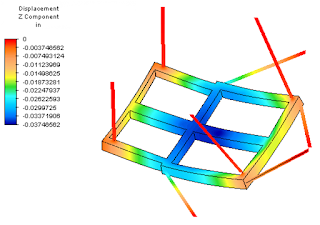After consultation with NASA (aka, Jeff Fox, Christie Sauers and Leland Dysart), the team has designed to go with steel as the material of choice. By switching to steel, the manufacturing time can be reduced. First, there are structural shapes already available, such as the
square tubing shown below, that can meet the required pallet dimensions better than the aluminum C channel originally selected. Steel will also be easier to weld than aluminum. The pallet will be stronger -- however, it will be heavier!
 |
| Typical square tubing, OnlineMetalsStore.com |
|
Before switching to square tubing, finite element analysis was performed using
Autodesk Algor Simulation 2011 to compare the stress and displacement experienced when using C channel versus square tubing, both made of A36 steel. Keep in mind that the loads applied are actually four times greater than expected in order to assure that the design will be strong enough. Below are some of the slides the team presented to NASA at the last design review. Based on these results, the square tubing is the preferred design cross section.
 |
| The tube displaces on 0.039 inches, compared to 1.8 inches for the C-channel. The cross section of the tubing makes it considerably stiffer. |
 |
| The square tube experiences about 42 ksi maximum von Mises stress while the channel experiences 138 ksi. |
The design has also been revised to ensure access to lockers that will be beneath the pallet in the mockup. The latest pallet design (called Version 3) is shown below. The material used in the tube channels is typically
ASTM A500 Grade B, a low carbon steel that includes copper as one of its alloying elements. Its ultimate strength is 56 ksi -- which is above the 42 ksi estimated by the current FEA analysis.
 |
| Pallet viewed from the top (3D model created in SolidEdge) |
 |
| Pallet viewed from the bottom (3D model created in SolidEdge). The webbing you see adds additional stiffness to that portion of the pallet. |
|
|
|
|
|















